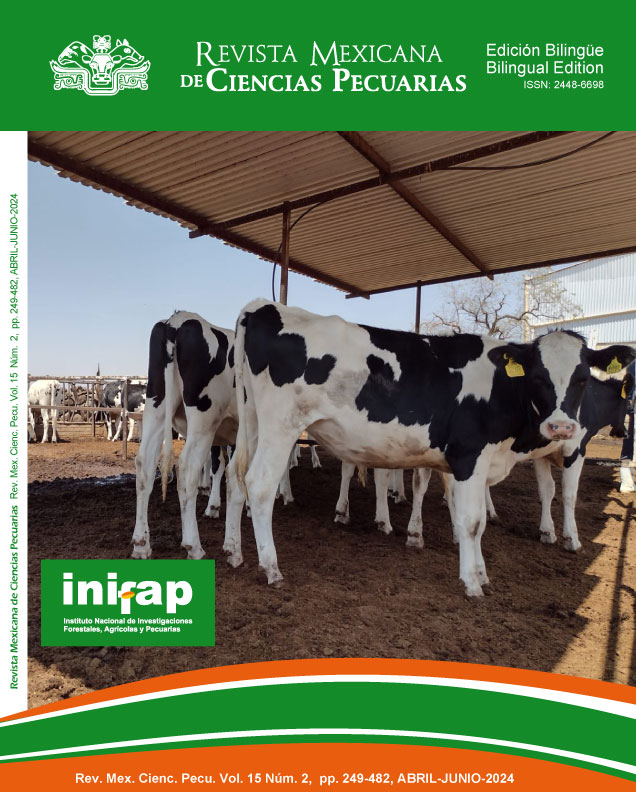Electron microscopy and X-ray diffraction analysis of equine enteroliths from the Aburrá Valley in Antioquia, Colombia
DOI:
https://doi.org/10.22319/rmcp.v15i2.6584Keywords:
Colic, Enterolithiasis, Equine, StruviteAbstract
The objective of this study was to determine the mineralogical composition of equine enteroliths from the Aburrá Valley in Antioquia, Colombia. Samples of eight enteroliths from eight horses were subjected to semi-quantitative X-ray diffraction (XRD) and transmission and scanning electron microscopy (TEM/SEM) analysis. The TEM/SEM of the analyzed enteroliths reported the presence of carbon, oxygen, phosphorus, magnesium, calcium, silicon, potassium, bromine, iron, sulfur, and aluminum. The XRD identified struvite, newberyte, kyanite, low quartz, actinolite, nitratine, cordierite, and vivianite. Both techniques used in the analysis of the enteroliths were correlated by matching the mineral compounds with the detected chemical elements. The main mineral components of the enteroliths were magnesium phosphates, struvite and newberyte being the most common.
Downloads
References
Hassel DM. Enterolithiasis. Clin Tech Equine Pract 2002;1(3):143-147. https://doi.org/10.1053/ctep.2002.35576
Pérez L, Calderón VR, Rodríguez MA, Jacinto ME. Estudio recapitulativo de cinco casos de enterolitiasis en caballos remitidos al hospital para équidos del DMZE FMVZ-UNAM, durante 2003. Vet Méx 2006;37:223-238.
Pierce RL. Enteroliths and Other Foreign Bodies. Vet Clin Equine 2009; 25:329-340. doi: 10.1016 / j.cveq.2009.04.010
Cohen ND, Vontur CA, Rakestraw PC. Risk factors for enterolithiasis among horses in Texas. J Am Vet Med Assoc 2000;216(11):1787-1794. https://doi.org/10.2460/javma.2000.216.1787
Hassel DM, Rakestraw PC, Gardner IA, Spier SJ, Snyder JR. Dietary risk factors and colonic pH and mineral concentrations in horses with enterolithiasis. J Vet Intern Med 2004;18:346-349. http://doi.org/10.1111/j.1939-1676.2004.tb02556.x
House AM, Warren LK. Nutritional management of recurrent colic and colonic impactions. Equine Vet Educ 2016;28:167-172. doi: 10.1111/eve.12543
Turek B, Witkowski M, Drewnowska O. Enterolithiasis in horses: analysis of 15 cases treated surgically in Saudi Arabia. Iran J Vet Res 2019;20(4): 270-276.
Nardi KB, Barros AMC, Zoppa ALV, Silva LCL, Ambrósio AM, Hagen SCF, Belli CB, Baccarin RYA, Fernandes WR, Spagnolo JD, Correa RR. Large bowel obstruction by enteroliths and/or foreign bodies in domestic equids: retrospective study of cases see from January 2003 to march 2020. Arq Bras Med Vet Zootec 2022;74: 83-92. http://dx.doi.org/10.1590/1678-4162-12442
Hassel DM, Spiers SJ, Aldridge BM, Watnick M, Argenzio RA, Snyder JR. Influence of diet and water supply on mineral content and pH within the large intestine of horses with enterolithiasis. Vet J 2009;182:44-49. doi:10.1016/j.tvjl.2008.05.016
Hassel DM, Aldridge BM, Drake CM, Snyder JR. Evaluation of dietary and management risk factors for enterolithiasis among horses in California. Res Vet Sci 2008;85(3):476-480. https://doi.org/10.1016/j.rvsc.2008.03.001
Rouff, AA, Lager GA, Arrue D, Jaynes J. Trace elements in struvite equine enteroliths: concentration, speciation and influence of diet. J Trace Elem Med Biol 2018;45:23-30. https://doi.org/10.1016/j.jtemb.2017.09.019
Vélez SAG, Patiño JJM, Martínez JRM. In vitro evaluation of the dissolving effect of carbonated beverages (Coca-Cola®) and enzyme-based solutions on enteroliths obtained from horses: pilot study. Braz J Vet Res Anim Sci 2021;58: 1-7. https://doi.org/10.11606/issn.1678-4456.bjvras.2021.182579
Hassel DM, Schiffman P, Snyder JR. Petrographic and geochemic evaluation of equine enteroliths. Am J Vet Res 2001;62(3):350-358. https://10.2460/ajvr.2001.62.350
Lloyd K, Hintz HF, Wheat JD, Schryver HF. Enteroliths in horses. Cornell Vet 1987;77:172-186.
Bray RE. Enteroliths: feeding and management recommendations. J Equine Vet Sci 1995;15(11):474-478. https://doi.org/10.1016/S0737-0806(06)81820-4
Neumann RD, Ruby AL, Ling GV, Schiffman PS, Johnson DL. Ultrastructure of selected struvite-containing urinary calculi from cats. Am J Vet Res 1996a;57:12-24.
Neumann RD, Ruby AL, Ling GV, Schiffman PS, Johnson DL. Ultrastructure of selected struvite-containing urinary calculi from dogs. Am J Vet Res 1996b;57:1274-1287.
Legeros RZ, Legeros JP. Phosphate minerals in human tissues. In: Nriagu, J.O.; Moore, P.B. (eds.) Phosphate minerals. Springer-Verlag Inc (Berlin). 1984;p.351-385. doi: 10.1007 / 978-3-642-61736-2_12
Kramer G, Klingler HC, Steiner GE. Role of bacteria in the development of kidney stones. Curr Opin Urol 2000;10:35-38. doi:10.1097 / 00042307-200001000-00009
Prywer J, Torzewska A. Bacterially induced struvite growth from synthetic urine: experimental and theoretical characterization of crystal morphology. Crys Growth Des 2009;9(8):3538-3543. https://doi.org/10.1021/cg900281g
Blue MG, Wittkopp RW. Clinical and structural features of equine enteroliths. J Am Vet Med Assoc 1981;179:79-82.
Downloads
Published
How to Cite
-
Abstract355
-
PDF (Español)128
-
PDF46
-
Texto completo (Español)16
-
Full text9
Issue
Section
License

This work is licensed under a Creative Commons Attribution-NonCommercial-ShareAlike 4.0 International License.

This work is licensed under a Creative Commons Attribution-NonCommercial-ShareAlike 4.0 International License.





